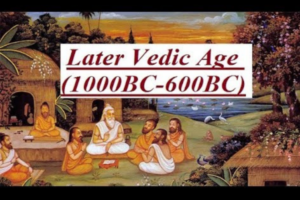Later Vedic age Understanding the later Vedic period
The article provides an insight to later Vedic Age and all the Vedas
Later Vedic period was the period in which three Vedas (Sama Veda, Yajur Veda and Atharva Veda) along with their respective brahmanas, Upanishads and Aranyakas were composed.

Sama Veda
- It is called as the book of chants; its collection of hymns has been taken mainly from the 8th and 9th mandalas of the Rig Veda.
- Shakhas or recensions of the Sama Veda are Kauthuma, Jaiminya (Talavakara) and Ranayaniya.
- It is smallest among all 4 vedas.
- It consists of samani.e melodies- a collection of1810 melodies
- These melodies were meant to be sung at the time of soma sacrifice (sung by Udgatri)
- It contains Dhrupada raga.
Read more: Newton’s Laws of Motion-Know Everything About It
Read more: Work Energy and Power: Let us understand the concept of SI units
YAJUR VEDA
- It consists of the various hymns for the purpose of recitation and rules to be observed at the time of sacrifice.
- The two ceremonies of Rajasuya and Vajapeya are mentioned for the first time in this Veda.
- It has 32 Upanishads
- The dialogue between Nachiketa and Yama is mentioned in Katha Upanishad.
- It is associated with Krishna Yajur Veda.
- There are 2 main texts-
1.Shukla Yajur Veda or Vajasaneyi , that contains only hymns (Madhyandina and Kanva)
- Krishna Yajur Veda that contains not only the hymns but also prose commentaries (Taittriya, Katha, Maitrayani and Kapisthala)
ATHARVA VEDA
- It provides the knowledge of magical formulae
- It is the last Veda and is considered a non-Aryan work
- It contains charms and spells to ward of evils and diseases
- It has 2 divisions- Paippalada and Saunakiya
- It is divided into 20 kandas(books) and has 711 hymns and a collection of 5987 mantras.
- The first reference to Anga and Magadha occurs in the Atharva Veda, where they are mentioned along with Gandhari and Mujavats
GEOGRAPHICAL BACKGROUND OF LATER VEDIC ERA
- Aryans occupied the upper Gangetic doab.
- In this period the they moved towards the eastern region as is evident from the story of Videha Madhava in Satpath brahmin, where he moved eastward Videha.
- The later Vedas gives three broad divisions of India viz Aryavrata (northern India), Madhyadesha (central India) and Dakshinapatha (southern India).
Society of later Vedic period
- The later Vedic society witnessed the growth of social divisions in the form of varna system.
- Another important institution that began to take shape was ashrama or the different stages of life.
- Caste exogamy was practiced in the society and a rigid social hierarchy was developed, which restricted the social mobility of the earlier period.
- In this age women were not allowed to attend assemblies and thus assemblies were dominated by the nobles.
- Sabha and samiti were still strong but Vidatha disappeared.
- There have been references to rare instances of child marriages and sati.
Economy of later Vedic period
- This society was rural based.
- Towards the end of this period there are traces of the beginning of urbanism, as Nagar in the sense of town is mentioned in the TaittiriyaAranyaka.
- The forest was cleared by burning the trees, which is also mentioned in the SatapathaBrahamana
- In this age collection of taxes and tributes was made mandatory and were done by Sangrihitri and the Vaishyas appear to be the only tribute payers.
CULTURE AND RELIGION OF LATER VEDIC PERIOD
- In the later Vedic age, sacrifices and rituals became prominent.
- Prayers were replaced by rituals paving way for priestly classes.
- Emergence of priesthood and Brahmanical domination
- Towards the end of later Vedicage, a strong reaction began to emerge against priestly domination, cults and sacrifices, especially in the land of Panchal and Videha where around 600 BC the Upanishads were compiled.
- Indra and Agni lost their importance and Prajapati took their place.
- Rudra and Vishnu became important.
- Idolatry became prominent
For more such informative articles stay tuned to OWN TV.
Facebook Comments
